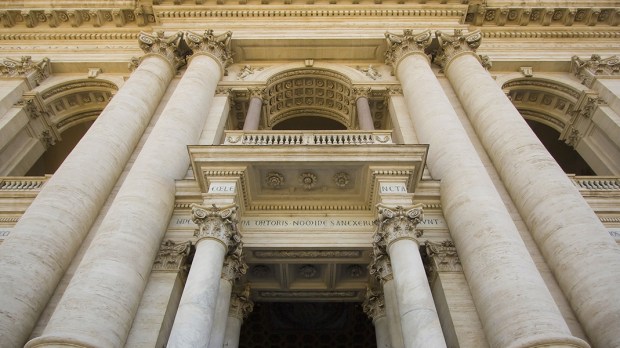As a convert, one of the things that attracted me to the Catholic Faith was its strong grounding in the physical world. Catholic teaching on the Real Presence, the Sacraments, and sacramental objects offered me a faith grounded in the real world, where Jesus wasn’t just a memory we commemorated through symbolism or a spiritual presence living invisibly in our hearts. No, for Catholics, he is flesh and blood, physically present all over the world in the Eucharist, and his grace is a tangible thing. Baptism, Confession, Communion, Confirmation, Marriage, Ordination, the Anointing of the Sick—these Sacraments are not just spiritual but physical acts, requiring proper form and matter, as well as intent.
The physicality of the Church is also exemplified by our use of sacramentals, or blessed objects, in living our faith. These objects can be almost anything, such as blessed salt, a crucifix, a “relic” or physical remnant of a long-departed saint, or even an entire building.
Today, November 9, we celebrate the physical nature of our faith as we commemorate the Feast of St. John Lateran—a feast day devoted not to a saint, but to a Church building. Located in Rome, the full name of the church in question is the Papal Archbasilica of St. John in the Lateran, but it is usually referred to by its more common, and often confusing name, St. John Lateran.*
(*The name is confusing because there has never been a “St. John Lateran.” “St. John” is the name of the church, and has, over the years, referred to both the Baptist and the Evangelist. Meanwhile, “Lateran” refers to its location on a property once owned by the wealthy Laterani family of Rome – more on that in a second.)
Most people think of St. Peter’s as “the Pope’s Church,” but it is not so. St. John Lateran is the actual cathedral church of the Diocese of Rome, over which the Pope presides as Bishop. On this feast day, we celebrate its dedication by Pope Sylvester I in the year 324 AD, when it became the first Western church where Christians could openly worship in public. (The actual building dedicated that year was later destroyed, as were several replacements. The present structure was commissioned by Pope Innocent X in 1646, and has survived to this day.)
St. John Lateran is notable for being the oldest church in the West, as well as for its significant role in the history of the Church. Five ecumenical councils have been held there, 28 popes have been laid to rest on its grounds, and tradition holds that the reliquaries over the main altar contain the heads of Sts. Peter and Paul. Until the 14th century Avignon papacy, the popes actually lived there, only moving to the Vatican upon returning to Rome and finding St. John Lateran in disrepair. But while there are many historically important churches in the Catholic faith, some of which also have their own days of commemoration (St. Mary Major on August 5, and Sts. Peter and Paul on November 18), only St. John Lateran has been given its own feast day, on par with Christian holy days honoring the saints and such miraculous events as the Immaculate Conception, the Assumption, the Ascension, and Pentecost.
So, how does a building get its own feast day, and why this one? After all, St. John Lateran is at least partially named after its origins as a palace built for the wealthy Laterani family before Constantine got his hands on it and, sometime later, donated it to the Church. How can a place with a pedigree rooted not in faith, but in selfish, materialistic excess become so important to God’s people that we celebrate it yearly with its very own feast?
Chalk it up to a redemption story. On at least some level, St. John Lateran’s is the story of how God can use anything and anyone to glorify Him and achieve His ends—even an ostentatious castle built for a single family at the height of an empire whose decadence proved its undoing. In celebrating the transformation of a symbol of secular domination into a holy place, we are reminded of our own conversions—from a people owned by the world, to God’s own children and heirs.
But that’s not all St. John Lateran’s legacy is about. By celebrating the dedication of the throne seat of the Bishop of Rome, we affirm our unity as Roman Catholics and once again proclaim the primacy of the Pope among all other bishops.
Not only that, but we remind ourselves of the importance of our own local churches. For Catholics, our cathedrals and parishes are not “just” buildings … they are spiritual homes for the faithful, places of rest and restoration, where we come to be parented (baptism, catechesis, confirmation), nourished by the Eucharist, and healed (reconciliation). Meanwhile, they serve as a physical home for Our Lord, whether He is concealed in the tabernacle, exposed for our adoration, or being sacrificed in the Mass for our spiritual and physical nourishment under the appearance of bread and wine.
As Catholics, our faith is physical. Church teaching affects the way we live our physical lives, we perform physical acts as markers of our faith, and we routinely bless mere objects in the belief that if God can turn bread and wine into the body and blood of His beloved son, He can use our everyday physical belongings to help us along in our spiritual journeys.
What better way to celebrate our physical, living faith than by honoring its physical home—St. John Lateran, the cathedral of Rome.

